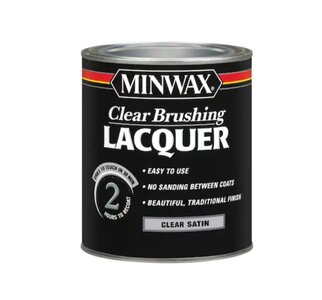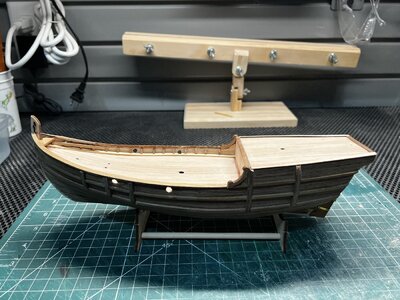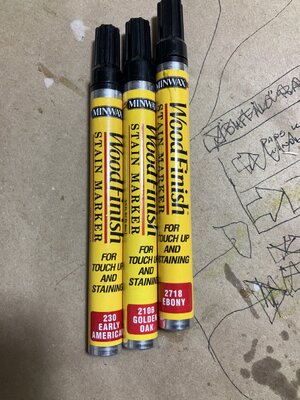You are using an out of date browser. It may not display this or other websites correctly.
You should upgrade or use an alternative browser.
You should upgrade or use an alternative browser.
Kurt Konrath
Kurt Konrath
You might want to look in the different section of the help at bottom of main page, there are several subjects about stains, varnish, oils and other substance to use on the ship.
When to apply stain, I think your there now for the main deck, but be award some stains or finishes effect the different glues ability to dry and hold.
When to apply stain, I think your there now for the main deck, but be award some stains or finishes effect the different glues ability to dry and hold.
Whatever your chosen finish turns out to be, try it on scrap first. You can avoid a mostly irreversible mistake.View attachment 351053
I’m at this point with my Pinta. Is this a good time to stain/varnish it? Also, what kinds of stains or finishes are best? Thanks
Last edited:
Good advice thanks!Whatever your chosen finish turns out o be, try it on scrap first. You can avoid a mostly irreversible mistake.
- Joined
- Oct 15, 2017
- Messages
- 986
- Points
- 403

Phil said it! I always test EVERYTHING. If I'm working with a stain, wood, metal, any material or different application of it I test it off the ship.
With staining work, the variable that has the most impact is the wood. Hard woods with tight grains and greater density have more uniform results. Softer woods with large grain variations produce less uniform and undesirable results. When I test any wood finish, using stain I will test with the application of sanding sealer and without. Sanding sealer prepares the wood surface for staining and IMO offers the best results on woods with less grain uniformity.
I've tried many sanding sealers before I found my go-to.
With staining work, the variable that has the most impact is the wood. Hard woods with tight grains and greater density have more uniform results. Softer woods with large grain variations produce less uniform and undesirable results. When I test any wood finish, using stain I will test with the application of sanding sealer and without. Sanding sealer prepares the wood surface for staining and IMO offers the best results on woods with less grain uniformity.
I've tried many sanding sealers before I found my go-to.
Last edited:
I have found it useful to first decide what my finished model might look like…then I stain and finish as I go. I tend to coat parts with clear matte finish polyurethane as I go. I have not experienced issues with either CA or PVA glues working on poly coated parts...such as gluing wale and molding planks to a poly coated planked hull. Most often my staining or painting is targeted to the historic coloring of the ship the model is representing. Otherwise I often use an oak stain to enrich the bass wood planking of a model or to represent a whee bit of weathering. I always try to stain decking planks to tone the deck to weathering or the effects of salt water stoning…
I generally use Minwax Natural Stain which just brings out the color of the wood without changing it. This works fine for hardwoods, but bass wood does not stain well in my experience.View attachment 351053
I’m at this point with my Pinta. Is this a good time to stain/varnish it? Also, what kinds of stains or finishes are best? Thanks
I really like this stuff. Works great as a sealer too.I have found it useful to first decide what my finished model might look like…then I stain and finish as I go. I tend to coat parts with clear matte finish polyurethane as I go. I have not experienced issues with either CA or PVA glues working on poly coated parts...such as gluing wale and molding planks to a poly coated planked hull. Most often my staining or painting is targeted to the historic coloring of the ship the model is representing. Otherwise I often use an oak stain to enrich the bass wood planking of a model or to represent a whee bit of weathering. I always try to stain decking planks to tone the deck to weathering or the effects of salt water stoning…

Is not it too late to stain after you glued the parts together? Even after sanding, some specs of glue will remain on the wood and they will prevent the stain to lay out evenly. Would not it be right staining the wood strips before gluing?
Some stains can interfere with glue adhesion. Especially oil-based stains. Staining is typically done after assembly but if you want to set areas that ill be stained vs areas that won't be stained, careful masking might be needed. Stain is normally applied by flooding, allowed to penetrate for a set time, then wiped back off - then left to cure. Glue squeeze out can be an issue.Is not it too late to stain after you glued the parts together? Even after sanding, some specs of glue will remain on the wood and they will prevent the stain to lay out evenly. Would not it be right staining the wood strips before gluing?
Thanks, Philski. Myself I still never used stains on my models. All scrap pieces I tried looked not satisfactory.Glue squeeze out can be an issue.
I've used polyurethane or tung oil with good results. They just enhance the wood's look. On my Galilee Boat, I used amber shellac and achieved good results. You couldn't even see the CA glue after coating the wood with shellac. PVA, on the other hand,...







